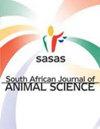Pre-treatments of Mirasolia diversifolia using Lactobacillus bulgaricus at different dosages and fermentation times: Phytic acid concentration, enzyme activity, and fermentation characteristics
IF 0.7
4区 农林科学
Q3 AGRICULTURE, DAIRY & ANIMAL SCIENCE
引用次数: 0
Abstract
The present study aimed to determine the optimal dosage and fermentation time of Mirasolia diversifolia (leaves and stems) using Lactobacillus bulgaricus bacteria by observing the reduction in phytic acid, the activity of enzymes, pH of fermentation, number of bacterial colonies, and tannin concentration. An experiment was conducted using a completely randomized design (CRD) and 2×3 factorial design with three replications. The treatment factors were Factor A (L. bulgaricus dosages): A1 = 2% (g/v), A2 = 3% (g/v); and Factor B (fermentation times): B1 = 1 d, B2 = 3 d, B3 = 5 d. The dosage of L. bulgaricus and fermentation time had an interaction on phytic acid and its degradation, enzyme activities, pH fermentation, and the number of bacterial colonies. Tannin concentration was not affected. Mirasolia diversifolia fermented with 3% of L. bulgaricus for 5 d resulted in the lowest phytic acid content. Future research requires evaluating in vitro and in vivo dietary formulations for cattle using M. diversifolia fermented with L. bulgaricus.使用保加利亚乳杆菌以不同剂量和发酵时间预处理 Mirasifolia diversifolia:植酸浓度、酶活性和发酵特性
本研究旨在通过观察植酸的减少、酶的活性、发酵的 pH 值、细菌菌落数和单宁酸浓度,确定使用保加利亚乳杆菌发酵 Mirasillus diversifolia(叶和茎)的最佳剂量和发酵时间。实验采用完全随机设计(CRD)和 2×3 因子设计,三次重复。处理因子为因子 A(保加利亚乳杆菌用量):A1 = 2% (g/v),A2 = 3% (g/v);因子 B(发酵时间):保加利亚乳杆菌用量和发酵时间对植酸及其降解、酶活性、发酵 pH 值和细菌菌落数有交互作用。单宁浓度未受影响。用 3% 的保加利亚酵母发酵 5 d 的 Mirasolia diversifolia 的植酸含量最低。未来的研究需要对使用保加利亚乳杆菌发酵的多花米兰的牛体外和体内日粮配方进行评估。
本文章由计算机程序翻译,如有差异,请以英文原文为准。
求助全文
约1分钟内获得全文
求助全文
来源期刊

South African Journal of Animal Science
农林科学-奶制品与动物科学
CiteScore
1.50
自引率
0.00%
发文量
39
审稿时长
>36 weeks
期刊介绍:
The South African Journal of Animal Science is an open access, peer-reviewed journal for
publication of original scientific articles and reviews in the field of animal science. The journal
publishes reports of research dealing with production of farmed animal species (cattle, sheep,
goats, pigs, horses, poultry and ostriches), as well as pertinent aspects of research on aquatic
and wildlife species. Disciplines covered nutrition, genetics, physiology, and production
systems. Systematic research on animal products, behaviour, and welfare are also invited.
Rigorous testing of well-specified hypotheses is expected.
 求助内容:
求助内容: 应助结果提醒方式:
应助结果提醒方式:


